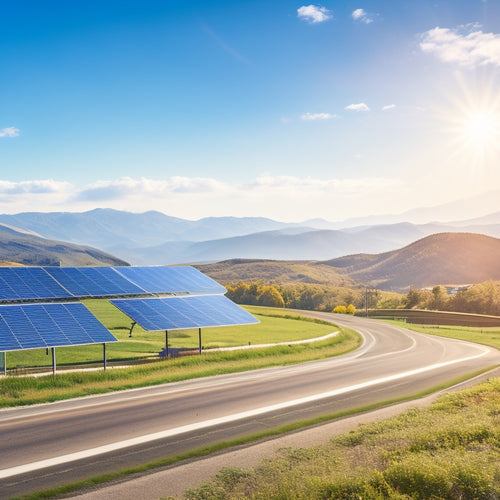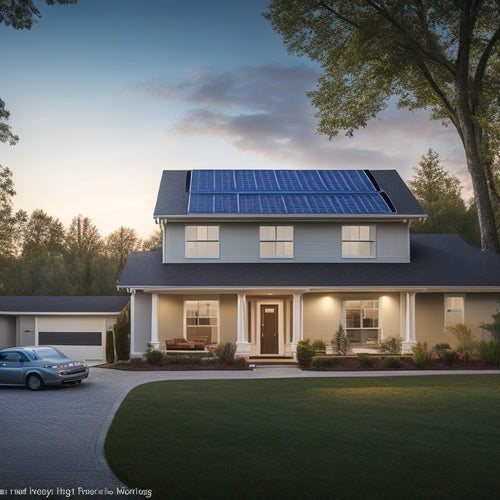
How to Calculate Home Energy System Costs
Share
To calculate home energy system costs, you'll need to evaluate the costs of solar panels, energy storage, and monitoring components. Start by determining the system size and component prices, including solar panels, inverters, and mounting hardware. Factor in installation and labor costs, which can vary depending on complexity and contractor experience. Don't forget to research and claim available incentives, such as federal tax credits and state rebate programs. Ongoing maintenance expenses, including preventive maintenance and performance assessments, will also impact your total cost of ownership. By accounting for these factors, you'll gain an extensive understanding of the financial implications - and the next step is to dig deeper into the specifics of each component to optimize your investment.
Overview
- Determine the system size in watts (W) to estimate costs, considering factors like energy needs and available roof space.
- Calculate the cost of solar panels, inverters, and mounting hardware, with prices ranging from $2.50 to $3.50 per watt.
- Factor in installation and labor costs, which vary by contractor and complexity, as well as permits and inspections.
- Consider incentives and rebates, such as federal tax credits and state-specific programs, to reduce overall costs.
- Add ongoing expenses, including maintenance, monitoring, and potential upgrades, to calculate the total cost of ownership.
Understanding Solar Panel Costs
When sizing up the feasibility of solar panels for your home, understanding the costs involved is vital. You'll want to take into account the type of solar panels, as they vary in efficiency and price.
Monocrystalline silicon panels are the most efficient, but also the most expensive. Polycrystalline silicon panels are a more affordable option, while thin-film panels offer the lowest upfront cost.
Additionally, it's important to evaluate solar panels with efficiency ratings above 20% and durable constructions for environmental resilience. The efficiency of your chosen panel type will impact the number of panels you need to meet your energy demands.
Higher-efficiency panels require less space, but may be more costly. You'll need to weigh these factors to determine the best option for your budget and energy needs.
System Size and Component Pricing
Your solar energy system's size and component pricing play a critical role in determining its overall cost and effectiveness. The system's size is measured in watts (W), and a larger system will generally cost more. However, a larger system can also provide more power and increase your energy independence.
| Component | Pricing Range |
|---|---|
| Solar Panels | $2.50 - $3.50 per watt |
| Inverter | $0.50 - $1.00 per watt |
| Mounting Hardware | $0.10 - $0.30 per watt |
When evaluating component pricing, consider factors like system efficiency and component lifespan. A more efficient system will produce more power per hour of sunlight, while a longer-lasting component will reduce replacement costs over time. By balancing system size and component pricing, you can optimize your solar energy system for maximum savings and freedom from utility bills.
Installation and Labor Costs
The installation process, including labor costs, is a significant factor in the overall expense of your solar energy system.
You'll need to take into account the cost of hiring a qualified contractor to install your system, which can vary depending on the complexity of the installation and the contractor's experience.
Additionally, you'll need to factor in the cost of permits and inspections required by your local government, which can add up quickly. A thorough permitting process guarantees your system meets safety standards and is installed correctly.
Moreover, a DIY installation can reduce labor costs, but it's crucial to evaluate the importance of proper system sizing to avoid oversizing or undersizing the kit.
During contractor selection, be sure to research and compare quotes from multiple contractors, and ask about their experience with similar installations.
Incentives and Rebate Programs
You'll be pleased to know that various incentives and rebate programs can help offset your home energy costs.
Federal tax credits, for instance, can provide a significant reduction in your tax liability, while state rebate programs offer cash back or other rewards for energy-efficient upgrades.
For example, the Federal Investment Tax Credit (ITC) offers up to 30% of total battery storage costs, including installation.
Additionally, utility incentives offered by your electricity or gas provider may also be available to you, further reducing the financial burden of going green.
Federal Tax Credits
Solar panels and energy-efficient upgrades can put a considerable dent in your wallet, but Uncle Sam is willing to lend a hand.
You're eligible for federal tax credits, which can considerably reduce your tax liability. To qualify, you'll need to meet specific eligibility requirements, such as installing qualified renewable energy equipment like solar panels or wind turbines.
The tax credit is a percentage of your investment, and you can claim it when filing your federal tax return. The application process involves completing Form 5695 and attaching it to your return.
State Rebate Programs
While federal tax credits provide a significant incentive, state rebate programs can further sweeten the deal, offering additional financial benefits for homeowners investing in energy-efficient upgrades or renewable energy systems.
You'll need to meet state eligibility criteria, which often involve income-based assistance or specific energy efficiency requirements. The rebate application process typically involves submitting documentation, such as environmental impact assessments and proof of installation.
Program funding sources vary, but may include local government incentives, community solar initiatives, or renewable energy certificates. Be sure to research state-specific regulations and program details, as they can impact the rebate amount and application process.
Utility Incentives Offered
Efficiency aligns with economy when utility companies offer incentives to homeowners who invest in energy-efficient upgrades or renewable energy systems. You can benefit from these incentives, which often come in the form of rebates or credits on your utility bills. These programs are designed to encourage homeowners like you to reduce their energy consumption and switch to cleaner sources of energy.
| Incentive Type | Description | Benefits |
|---|---|---|
| Rebate Programs | One-time cash incentives for energy efficiency upgrades | Reduced upfront costs for upgrades |
| Net Metering | Credits for excess energy generated by renewable systems | Lower utility bills and potential income |
| Time-of-Use (TOU) Rates | Discounted utility rates for off-peak energy usage | Savings on utility bills with flexible energy use |
Energy Storage System Expenses
When calculating energy storage system expenses, you'll need to factor in the cost of the battery units themselves, which can vary depending on the type, size, and brand you choose.
Additionally, you'll need to take into account installation expenses, including labor costs, wiring, and mounting hardware.
Battery Unit Costs
Your energy storage system's battery unit costs are a significant expense to evaluate when calculating your home's energy costs.
You'll want to take into account the cost of the battery itself, which can vary depending on the type and quality of the technology used. Look for batteries with high efficiency and a long lifespan to maximize your energy storage capacity.
Additionally, contemplate the warranty offered by the manufacturer and the availability of recycling programs at the end of the battery's life.
Proper battery sizing and integration with your energy system are also vital to guarantee peak performance.
Installation Expenses
The installation expenses of your energy storage system are a critical component of the overall cost calculation, as they can greatly impact the final bill.
When calculating installation expenses, you'll need to take into account site preparation costs, such as clearing land, grading, and foundation work. Equipment selection also plays a significant role, as the type and quality of components can affect labor costs and overall system performance.
You'll need to factor in the cost of inverters, mounting hardware, and electrical connections. Additionally, take into account the cost of permits, inspections, and any necessary upgrades to your electrical panel.
Monitoring System Price Factors
Determine the cost-effectiveness of your home energy monitoring system by factoring in the upfront installation cost, ongoing subscription fees, and any additional hardware or software requirements.
You'll need to evaluate the type of monitoring technology you're using, as advanced systems with real-time data analytics can be more expensive. The cost of data analytics software, which provides information into your energy usage, should also be included in your calculations.
Additionally, you may need to purchase additional hardware, such as sensors or smart plugs, to monitor specific areas of your home. Be sure to research the costs of these components and factor them into your overall monitoring system price.
Ongoing Maintenance Expenses
As you've factored in the upfront costs of your home energy monitoring system, it's now important to reflect on the ongoing expenses that will impact its overall cost-effectiveness. Preventive maintenance is vital to guarantee system longevity and ideal performance. You'll need to evaluate maintenance frequency, service contracts, and warranty coverage to determine the best approach for your system.
| Maintenance Aspect | Cost Range | Frequency |
|---|---|---|
| Technician Training | $500 - $1,000 | Bi-annually |
| Performance Assessments | $200 - $500 | Quarterly |
| System Upgrades | $1,000 - $3,000 | Annually |
When comparing costs, weigh the benefits of regular maintenance, such as extended system lifespan and reduced repair costs. By factoring in these expenses, you'll get a more accurate representation of your system's total cost of ownership, allowing you to make informed decisions about your energy monitoring investment.
Frequently Asked Questions
Can I Install a Home Energy System Myself to Save Money?
You can attempt a DIY installation to tap into cost-saving benefits, but beware: improper setup can void warranties, compromise system efficiency, and even pose safety risks, so weigh the risks against potential savings before diving in.
How Long Does It Take to Recoup the Cost of a Home Energy System?
As you utilize the power of independence, you wonder how long it'll take to reap the financial rewards. Conduct a cost analysis to determine the payback period, and you'll find it's typically 5-10 years, depending on system size, local incentives, and energy usage.
Are Home Energy Systems Affected by Weather Conditions Like Hurricanes?
You're right to wonder if home energy systems can withstand severe weather conditions like hurricanes; prioritizing hurricane preparedness and energy system resilience guarantees your system remains operational, even in extreme weather, giving you freedom from grid dependence.
Can I Add Energy Storage to an Existing Solar Panel System?
As you utilize the power of the sun, you're building a safety net; now, you can upgrade your existing solar panel system by adding energy storage options, ensuring seamless solar panel compatibility, and amplifying your energy independence.
Do Home Energy Systems Require Special Insurance Coverage?
You'll want to review your insurance policy to guarantee it covers your home energy system, as standard policies might not include coverage for renewable energy components; consider specialized coverage options to avoid increased insurance premiums.
Ready to Buy
You've made it to the final step in calculating your home energy system costs. You now have a thorough understanding of the various components that impact your system's overall price. Don't let upfront costs scare you off - remember, energy savings and potential increases in your property value can offset these expenses in the long run. With the right system and financing options, you can start reaping the benefits of renewable energy today.
Related Posts
-

What Do I Need to Know About Farm Solar Panels
When considering farm solar panels, you need to assess costs, benefits, and technical specifics. Initial investment c...
-

Is Switching to Green Energy Solutions Easy
Switching to green energy solutions isn't just easy; it's also beneficial. You can greatly cut utility costs and enjo...
-

Cost of Solar With Battery Backup
You're investing in a solar panel system with battery backup to guarantee reliable power during outages. The cost of ...


